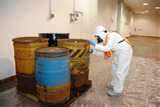
Lots of GHS Progress Happening This Year
The first of two important EU phase-in deadlines arrives a few days before the UNECE Sub-Committee of Experts on the Globally Harmonized System of Classification and Labelling of Chemicals meets Dec. 7-9 in Geneva.
The 20th meeting of the UNECE Sub-Committee of Experts on the Globally Harmonized System of Classification and Labelling of Chemicals, also known as GHS, will take place Dec. 7-9, 2010, in Geneva. While a detailed agenda has not yet been completed, the preliminary agenda indicates a U.S. expert may present an analysis requested by the sub-committee in mid-2009 of practices and regulations in place for combustible dust.
Dec. 1, 2010, is also significant because it is the first of two phase-in implementation deadlines for REACH and the date when companies in the European Union must apply CLP, the new European Regulation on Classification, Labelling and Packaging, to chemical substances. A second deadline in June 2015 is set for applying CLP to chemical mixtures. The CLP rule sets a new system in place throughout the European Union for classifying and labeling chemicals that is based on GHS.
At the Geneva meeting, Australia is scheduled to present a final report summarizing the GHS classification lists maintained by each country, their plans for lists to support GHS implementation, how various sectors in different countries use classification lists now, and what future needs there are for such lists.
The sub-committee's June 30-July 2, 2010, meeting showed how GHS implementation is advancing around the world. It became mandatory for chemical substances in the Republic of Korea on July 1, 2010, and will be mandatory for mixtures there on July 1, 2013. Switzerland allowed consumer products classified and labeled in accordance with GHS to be sold as of July 1, 2010, but its reclassification of substances will not be in force until December 2012. Serbia adopted a law implementing GHS on June 29, 2010, that sets a transition period for CLP implementation ending Sept. 1, 2011, for substances and June 1, 2015, for mixtures. Two standards implementing GHS in China took effect May 1, 2010, and a system for coordinating GHS implementation by government and industry is being developed there. Australia expects to release a GHS implementation regulation for public comment in September 2010, and in the United States, OSHA is now drafting its Hazard Communication final rule implementing GHS.